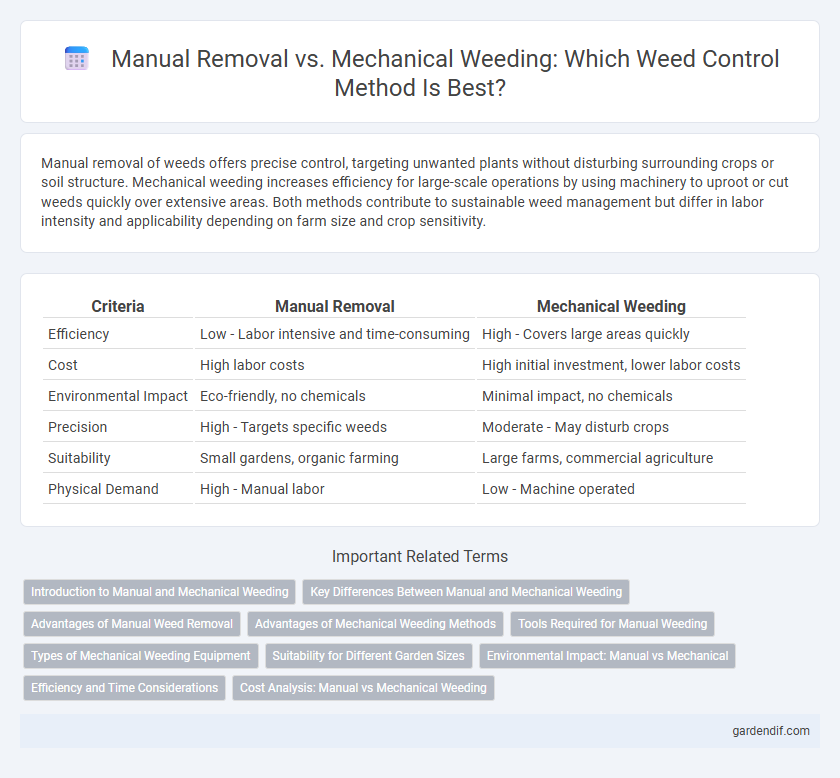
Manual Removal vs Mechanical Weeding Illustration
Manual removal of weeds offers precise control, targeting unwanted plants without disturbing surrounding crops or soil structure. Mechanical weeding increases efficiency for large-scale operations by using machinery to uproot or cut weeds quickly over extensive areas. Both methods contribute to sustainable weed management but differ in labor intensity and applicability depending on farm size and crop sensitivity.
Table of Comparison
| Criteria | Manual Removal | Mechanical Weeding |
|---|---|---|
| Efficiency | Low - Labor intensive and time-consuming | High - Covers large areas quickly |
| Cost | High labor costs | High initial investment, lower labor costs |
| Environmental Impact | Eco-friendly, no chemicals | Minimal impact, no chemicals |
| Precision | High - Targets specific weeds | Moderate - May disturb crops |
| Suitability | Small gardens, organic farming | Large farms, commercial agriculture |
| Physical Demand | High - Manual labor | Low - Machine operated |
Introduction to Manual and Mechanical Weeding
Manual removal involves physically uprooting weeds by hand or using handheld tools, offering precise control and minimizing damage to surrounding plants. Mechanical weeding employs machinery such as cultivators or hoeing devices to efficiently remove weeds over larger areas, boosting productivity and reducing labor intensity. Both methods aim to manage weed growth but differ in scalability, labor requirements, and suitability for crop type and field conditions.
Key Differences Between Manual and Mechanical Weeding
Manual removal targets weeds individually using hand tools, offering precise control and minimal damage to surrounding plants, ideal for small-scale or delicate crops. Mechanical weeding employs machinery to disturb soil and uproot weeds efficiently over large areas, enhancing speed and reducing labor costs but potentially causing soil disruption and non-selective plant damage. The choice between manual and mechanical methods depends on factors like crop type, field size, and weed density, balancing control precision against operational efficiency.
Advantages of Manual Weed Removal
Manual weed removal offers precise control, targeting individual weeds without disturbing surrounding crops or soil structure. This method reduces the risk of chemical residues in the environment, promoting organic farming practices. Labor-intensive but effective for small-scale gardens and sensitive ecosystems, manual weeding ensures thorough elimination of weeds, including root removal to prevent regrowth.
Advantages of Mechanical Weeding Methods
Mechanical weeding methods offer increased efficiency by covering larger areas quickly compared to manual removal, significantly reducing labor costs and time. These techniques improve soil health by minimizing disturbance and promoting aeration, which supports better weed control and crop growth. Advanced machinery allows precise targeting of weeds, decreasing herbicide use and fostering sustainable agricultural practices.
Tools Required for Manual Weeding
Manual weeding requires basic tools such as hand trowels, hoes, weed pullers, and gloves to effectively remove weeds from garden beds and cultivated areas. These tools enable precise targeting of weeds at their roots, minimizing damage to surrounding plants and soil structure. Compared to mechanical weeding, manual removal demands less costly equipment and allows for selective weed control in diverse planting environments.
Types of Mechanical Weeding Equipment
Mechanical weeding equipment includes rotary hoes, tine weeders, and inter-row cultivators designed to uproot or disrupt weeds effectively. Rotary hoes consist of spiked wheels that break soil crust and uproot weed seedlings, enhancing soil aeration. Tine weeders use flexible metal tines to agitate the soil surface, removing small weeds without damaging crops, while inter-row cultivators target weeds between crop rows with adjustable blades or shanks for precision.
Suitability for Different Garden Sizes
Manual removal excels in small gardens where precise targeting of individual weeds is essential, offering low-cost and environmentally friendly control. Mechanical weeding is more suitable for larger gardens or commercial plots, as it covers extensive areas quickly and reduces labor intensity. Choosing between these methods depends on garden size, weed density, and available resources for maintenance.
Environmental Impact: Manual vs Mechanical
Manual removal minimizes soil disturbance and conserves beneficial microorganisms, reducing environmental degradation compared to mechanical weeding. Mechanical weeding often leads to soil erosion, compaction, and increased carbon emissions from fuel-powered equipment. Choosing manual methods supports biodiversity and maintains soil health by avoiding the negative ecological footprint of machinery.
Efficiency and Time Considerations
Manual removal of weeds offers precision and is ideal for small-scale gardens or sensitive crop areas where selective weeding is crucial, but it is labor-intensive and time-consuming. Mechanical weeding uses tools like cultivators or automated machines to cover larger areas quickly, significantly reducing labor time and increasing efficiency on expansive farms. The choice depends on balancing crop sensitivity, field size, and available labor to optimize weed control efficiency and overall time management.
Cost Analysis: Manual vs Mechanical Weeding
Manual weeding incurs higher labor costs due to intensive human effort, averaging $30 to $50 per hour, while mechanical weeding involves upfront equipment investment but reduces ongoing labor expenses significantly. Mechanical weeding systems, such as rotary hoes or cultivators, can cover large areas quickly, lowering the cost per acre to approximately $15 to $25 compared to $40 to $60 for manual removal. Factoring in long-term productivity and equipment maintenance, mechanical weeding offers better cost-efficiency for expansive farms, whereas manual removal remains viable for small-scale or high-value crops.
Manual Removal vs Mechanical Weeding Infographic

 gardendif.com
gardendif.com